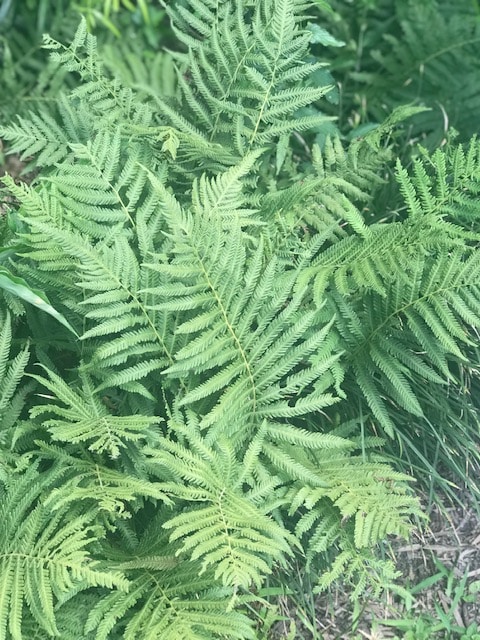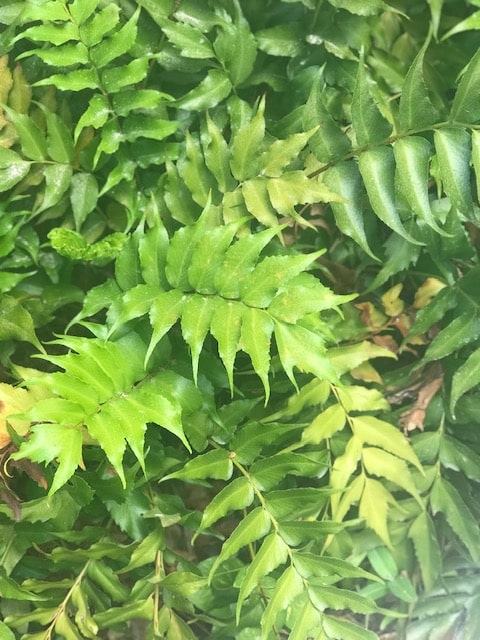By Lori Murray, Cameron County Master Gardener, Texas Superstar Specialist
It’s amazing to know that some of the 12,000 species of fern we identify today were living even before the dinosaur age; that, in fact, the fern was one of the first plants on earth.Since this is one of the few plants which will grow profusely in shady areas, it’s good to remember that a few present-day varieties will do well in our Valley heat and some that even survive our Valley cold. My holly fern, for example, lived uncovered through the freeze as if nothing at all had happened.
Holly Fern has firm, leathery leaves which are broader than those of most fern and can grow to about 20 inches in length. The shiny deep green fronds rise ina spiral from an erect crown and keeps increasing its diameter as it grows older. This vase-shaped evergreen fern is coldhardy. Plant inmoist soil enriched with either peat moss or compost. Holly fern will take some morning sun, but should be shaded from the hot afternoon rays. Periodically groomthe fern by pulling out the lowest fronds showing dryness and brown edges.
Sword Fern (Nephrolepis exaltate) and Boston Fern (Nephrolepis exaltata cv. Bostoniensis) are native to tropical regions throughout the world and commonin humid forests and swamps. Sword Fern is also known as the Wild Boston fern, Tuber Ladder fern, or Fishbone fern. The fronds are extremely long and broad with alternate leaflets on either side of the midrib which make the edges appear slightly serrated.
Sword Fern has erect fronds while Boston fern has gracefully arching fronds. Since this difference was discovered in a shipment of Sword Fernfrom Boston to Philadelphia in 1894, the trip might be the basis of the name. Other ideas for the origin of the term Boston fern were documented by David Fairchild who stated the term came from Florida pioneer nurseryman John Soar who sent the plants to his friend in Boston. (Wikipedia) Like holly fern, this fern also does well in shade but does not like the afternoon sun.
Once established, it will fill in beds by spreading from underground runners of older plants. The fronds will reach one to two feet in height.Boston Fern does well here, although it can die back permanently in very cold weather. It is a very popular house plant, often grown in hanging baskets both indoors and out, and is perennial and usually hardy in our zone.

Indoors it’s necessary to mist the fronds.. Although this plant prefers partial to full shade when it’s outdoors, indoors it grows in bright filtered light. In general, Boston Fern likes damp but not soggy soil that is rich in nutrients. Boston Fern will tolerate some drought, but thrives in humid conditions such as the Valley. Propagate by dividing the root runners.
Interestingly, the Boston Fern is classified as an invasive plant in South Africa,and in some provinces it must, bylaw, be eradicated. In many provinces, a permit is required to import, possess, grow, breed, move, sell, buy, or accept one as a gift.
Macho Fern(Nephrolepis biserrata), also called Giant Sword Fern,is aptly named as it is one of the largest ferns to do well in our Valley. The dark green fronds can grow to be three or four feet tall. Like Sword fern, this plant will spread from underground runners. It will take cold temperatures, but not a freeze; it will, however usually come back very very slowly after a freeze. Propagate by dividing the rootball, and plant in a pot, a hanging basket, or a bed.
Another fern, and one which I have greatly enjoyed, is what my mother-in-law called River Fern. I have a bed of it on the northwest corner of my house and it not only thrives in the afternoon sun, but was impervious to our freeze in February. I use it for flower arrangements because it’s a fragile looking silky fern that fills the vase nicely but doesn’t take anything away from the flowers themselves. Some of you may have it as well, and if you know a better or more accurate name for it, please let me know.
It’s easy to be taken with the wonderful tropical blooms that will flourish here in our Valley landscapes,but we need to also remember that the right fern can fill a shady space in the yard with subtle variations of color and form and lend a finished look to an area which needed completion.




